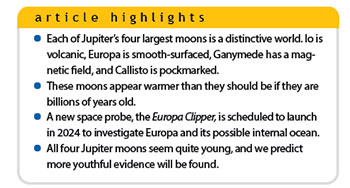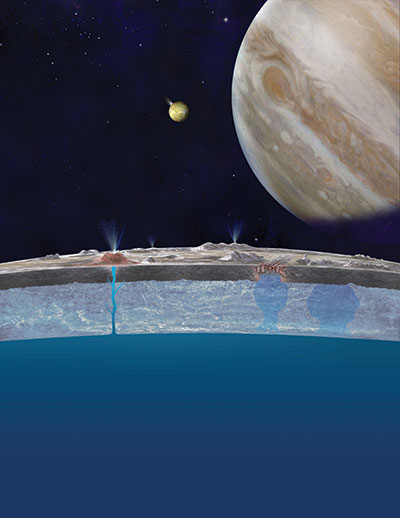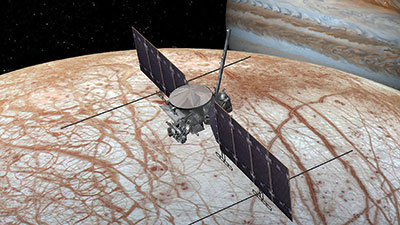 In 1610, Galileo Galilei aimed his telescope at Jupiter and discovered the four largest of the planet’s 95 known moons. He recognized them as satellites, and they became known as the Galilean moons. In order of increasing distance from Jupiter, they are Io, Europa, Ganymede, and Callisto (Figure 1).
In 1610, Galileo Galilei aimed his telescope at Jupiter and discovered the four largest of the planet’s 95 known moons. He recognized them as satellites, and they became known as the Galilean moons. In order of increasing distance from Jupiter, they are Io, Europa, Ganymede, and Callisto (Figure 1).
Four Warm Moons
Most, if not all, of the Galilean moons show evidence of interiors that are at least fairly warm. Generally, there are three ways to warm such bodies.
- Leftover warmth: The moons could still be losing the energy they had at the time they formed. For scientists who hold to evolution and millions of years, however, this is not an option since small bodies like Jupiter’s moons should have lost this energy to space eons ago. But it is an option for biblical creationists, as these moons could still be cooling off 6,000 years after the Lord Jesus created them.
- Heat produced by radioactive decay: Because radioactive elements are quite heavy, this is not always an option for small, low-mass moons.
- Tidal heating or flexing: Jupiter and its moons exert gravitational tugs on one another, and these tugs flex or stretch the moons’ interiors, heating them.
Conventional scientists think radioactivity and tidal heating can explain the warmth of these moons, but their explanations often require special conditions that may or may not hold. Thus, the warmth of these moons is a potential problem for “deep time.” But even if, for the sake of argument, one grants them these special conditions, problems still remain for the old-universe view.
Io
Io is the most volcanically active body in our solar system. The colors of its surface are due to the different temperatures of various sulfur-containing compounds. Io’s volcanism is so intense that at today’s rates, it would have turned itself “inside out” more than 100 times in 4.6 billion years.1 Radioactivity can only make a small contribution to Io’s heat output, so uniformitarian scientists attribute most of Io’s present-day heat to tidal flexing.2
For a long time, creationists made much of the fact that simple models of tidal flexing could only produce a small fraction of Io’s observed heat output. This was an argument for youth because the only remaining option to explain Io’s warmth was leftover heat from its formation, which is only possible if Io is young.1
But these previous calculations focused mainly on gravitational tugs that Jupiter exerted on Io and the other Galilean moons. It was assumed that the tugs the moons exerted on each other were not as important. A recent paper, however, claims that this inter-moon tidal heating can be significant if the moons have subsurface liquid or magma oceans. If so, previous tidal heating estimates for these moons may need to be significantly revised.3,4
So, present-day tidal flexing might be capable of explaining Io’s heat output after all. This idea only works, though, if the presumed subsurface oceans have just the right thicknesses.3,4 Until additional data or calculations shed more light on the issue, I would caution against dogmatism on this point.
Even so, Io still presents problems for evolutionists because its erupting lavas are rich in magnesium. Geologists would say they are ultramafic. But magnesium is a heavy element, and magnesium should have settled deep into Io’s interior after billions of years. In that case, lavas on Io should be depleted in magnesium, but this isn’t the case.
The idea that Io’s crust is ultramafic (magnesium-rich) seems inconsistent with the well-understood process of magmatic differentiation. Heat flow on Io is sufficiently high that Io was expected to have undergone partial melting and differentiation hundreds of times, producing a low-density crust, depleted in heavy elements like magnesium.5
Some scientists think a completely molten core and a crystal-rich magma ocean together could explain how Io’s crust could still be magnesium-rich after billions of years.5 But both possibilities are disputed by other uniformitarian scientists.6
Another option for evolutionists is to claim that Io’s volcanism was much weaker in the past and only recently intensified. This would explain the presence of magnesium in Io’s crust. But this would mean that we’re lucky to be observing Io at such a special time in its history.
Europa

Europa has a smooth, young-looking surface. Long scratches or fractures on its surface called lineae are thought to be caused by tides in a large subsurface “shell” of liquid water, a kind of “stealth” ocean (Figure 2). In the past, conventional scientists have had trouble explaining Europa’s apparent warmth,7 although some argue that radioactivity and tidal heating together may be a plausible explanation.
Because liquid water is necessary for life as we know it, evolutionary scientists think finding liquid water in space will make the evolutionary story seem more plausible. However, although water is necessary for life to exist, it’s not sufficient. Water is actually a problem for evolutionary origin-of-life scenarios since it breaks down the complex molecules that evolutionists claim formed spontaneously in chemical soups billions of years ago.8
Ganymede
Ganymede is the largest of the four Galilean moons and exceeds the size of the planet Mercury. Some think that it too has a subsurface ocean. Conventional scientists were surprised that Ganymede has its own magnetic field. Uniformitarian scientists invoke a dynamo theory to explain how magnetic fields of planets and moons can persist for billions of years. However, the dynamo theory has many problems.9 It requires the magnetic moon or planet to have a molten core, which requires a warm interior. Radioactivity and tidal heating are thought to be insufficient explanations for Ganymede’s apparent warmth (but see the Io discussion above), so Ganymede was expected to be too cold for its own magnetic field.10
Some scientists have suggested that iron “snow” or the formation of iron-sulfide crystals within the core could help provide the necessary heat. But these proposals require particular concentrations of sulfur in the core that may or may not be present.10-12 The iron-sulfide mechanism could theoretically work for about 3.8 billion years,11,12 but it requires the core to initially be about 36% sulfur by weight, which is a “very high” concentration of sulfur that could contradict cosmic evolutionary theories regarding Ganymede’s origin.13 The “iron snow” mechanism, on the other hand, can only provide heat for at most about 800 million years.11,12
This would mean that again we’re simply lucky to be able to observe Ganymede’s short-lived magnetic field at a special time in its history.
Callisto
Callisto is the most heavily cratered object known in the solar system. By uniformitarian reckoning, the large number of craters implies that the moon is very old, in contrast to the apparent youth of Europa’s smooth surface. However, age estimates based on craters are very uncertain. There’s some evidence that Callisto also has a subsurface liquid ocean. Conventional scientists were surprised by this, as Callisto is far enough away from Jupiter and the other Galilean moons that heat from tidal flexing was thought unimportant.
Radioactivity can provide some heat, but conventional scientists thought this heat would escape to space in a few hundred million years. For this reason, they were shocked by evidence for a subsurface ocean. “But people didn’t quite believe it. How could Callisto have an ocean?” asked Jeffrey Kargel of the U.S. Geological Survey.14 Some think sufficient amounts of an “antifreeze” such as ammonia, or perhaps certain salts, could help explain the existence of such oceans.15 But of course, we don’t know how much of these quantities, if any, are actually present in these oceans, assuming they exist.
Water, Water Everywhere?
Europa has the strongest evidence for a subsurface ocean. There’s also good evidence for such an ocean on Saturn’s moon Enceladus. Some scientists think subsurface oceans may also exist on a dozen or so other small bodies within our solar system. Some of this could be evolutionists’ wishful thinking due to their strong desire to find liquid water in space.
Even so, creationists should be excited about the possibility. Subsurface oceans of liquid water cannot exist unless these moons are relatively warm, and multiple warm small moons are much easier to explain if the solar system is young. As noted by one researcher:
Maintaining subsurface oceans against freezing over geological times requires a fine balance between internal heating and heat loss, and yet we have several pieces of evidence that Europa, Ganymede, Callisto and other moons should be ocean worlds.4
So, what are the odds that several (and perhaps more) small bodies in our solar system maintained such a “fine balance” for billions of years? Alternately, what are the odds that these bodies only recently became warm enough to maintain liquid oceans and that we are just in the right place at the right time to observe them?

Conclusion
Uniformitarian explanations for the warmth of these moons often require special conditions in the moons’ interiors that may or may not exist. They also often require us to assume that we’re simply lucky to be seeing these moons at this special time in their history. This bothers evolutionary scientists because it seems that there are many such “coincidences” in our solar system.
The most active bodies out there—Jupiter’s moon Io and Saturn’s moons Enceladus and Titan—may be putting on limited-run shows that humans are lucky to witness. Saturn’s brilliant rings, too, might have appeared relatively recently, and could grow dingy over time. Some such proposals make planetary researchers uncomfortable, because it is statistically unlikely that humans would catch any one object engaged in unusual activity—let alone several.16
Of course, all these observations are easily explained if our solar system is young. Creationists should look forward to data from the upcoming Europa Clipper and other missions to Jupiter’s moons (Figure 3), as these will likely strengthen the argument that Jupiter’s moons were created recently. None of this should be surprising, since according to Scripture the Lord Jesus Christ created our solar system—along with the rest of our universe—just 6,000 years ago.
References
- Spencer, W. 2020. The volcanism and age of Io. Journal of Creation. 34 (2): 117-123.
- Thomas, N. 2022. A comprehensive investigation of the Galilean moon, Io, by tracing mass and energy flows. Experimental Astronomy. 54: 791-807.
- Hay, H. C. F. C., A. Trinh, and I. Matsuyama. 2020. Powering the Galilean Satellites with Moon-Moon Tides. Geophysical Research Letters. 47 (15): e2020GL088317.
- Mace, M. Jupiter’s Moons Could Be Warming Each Other. University of Arizona news release. Posted on news.arizona.edu September 10, 2020, accessed February 24, 2023.
- Lopes, R. M. C. 2007. Io: The Volcanic Moon. In Encyclopedia of the Solar System, 2nd ed. L.-A. McFadden, P. R. Weissman, and T. V. Johnson, eds. Amsterdam: Academic Press, 428. Emphasis in original.
- Ogasa, N. Io may have an underworld magma ocean or a hot metal heart. Science News. Posted on sciencenews.org December 22, 2022, accessed February 13, 2023.
- Spencer, W. 2015. Warm icy moons. Journal of Creation. 29 (3): 97-103.
- Vieira, A. d. N. et al. 2020. The ambivalent role of water at the origins of life. FEBS Letters. 594 (17): 2717-2733.
- Humphreys, D. R. 2013. Planetary Magnetic Dynamo Theories: A Century of Failure. In Proceedings of the Seventh International Conference on Creationism. M. Horstemeyer, ed. Pittsburgh, PA: Creation Science Fellowship, 7: 5.
- Spencer, W. 2022. The iron snow dynamo theory for Ganymede. Journal of Creation. 36 (3): 3-5.
- Rückriemen, T., D. Breuer, and T. Spohn. 2018. Top-down freezing in a Fe-FeS core and Ganymede’s present-day magnetic field. Icarus. 307: 172-196.
- Can a Top-down Freezing Core Explain Ganymede’s Magnetic Field? Science Trends. Posted on sciencetrends.com August 22, 2018, updated March 14, 2020, accessed February 13, 2023.
- Bland, M. T., A. P. Showman, and G. Tobie. 2008. The production of Ganymede’s magnetic field. Icarus. 198 (2): 384-399.
- Klarreich, E. Callisto’s watery secret. Nature News. Posted on nature.com July 26, 2001.
- Spohn, T. and G. Schubert. 2003. Oceans in the icy Galilean satellites of Jupiter? Icarus. 161 (2): 456-467.
- McKee, M. 2013. Planetary Science: Caught in the act. Nature. 493 (7434): 592-596.
* Dr. Hebert is Research Scientist at the Institute for Creation Research and earned his Ph.D. in physics from the University of Texas at Dallas.



